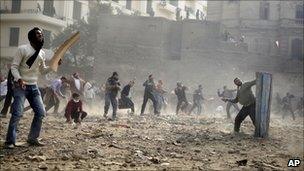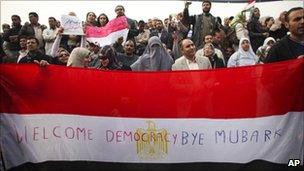Egypt protests: Key moments in unrest
- Published
Following more than two weeks of protests, Egypt's Hosni Mubarak has stepped down as president, ending three decades in power. What are the key events that led to this moment?
14 January: Tunisian president flees

Weeks of protests in Tunisia led to President Ben Ali fleeing the country
President Zine al-Abidine Ben Ali steps down and flees the country following weeks of anti-government protests and clashes with police.
The protests there were inspired by the self-immolation of a frustrated unemployed young man, Mohammed Bouazizi, in December.
The toppling of Mr Ben Ali after 23 years in power help galvanise the current anti-government protests in Egypt.
25 January: Protests begin in Egypt
Thousands of people join protests in several Egyptian cities after an internet campaign.
Clashes break out in Cairo's Tahrir Square between riot police and protesters, who say they are fed up with high levels of poverty, corruption and unemployment. Some protesters say they will not give up until President Mubarak steps down.
28 January: Unrest spreads
The protests in Egypt continue and gather momentum. President Mubarak declares a curfew in Cairo, Alexandria and Suez and the army is deployed. The curfew is immediately and widely flouted, and there are further clashes between protesters and police amid growing reports of looting and lawlessness.

There were two days of clashes around Tahrir Square between pro- and anti-Mubarak groups
After Friday prayers, tens of thousands of people join protests in Cairo and other cities to press the demand that Mr Mubarak step down.
The headquarters of the governing NDP party is set ablaze, while protesters also besiege the state broadcaster and the foreign ministry.
Late on Friday, President Mubarak sacks his cabinet. In a televised address, he says he understands the protesters' grievances but defends the actions of the security forces. At least 26 people are reported to have died since the unrest began.
President Barack Obama calls Mr Mubarak after his speech, telling him he must give meaning to his pledges to provide better economic and democratic opportunities to the Egyptian people.
29 January: Suleiman appointed vice-president
President Mubarak names intelligence chief Omar Suleiman as his first-ever vice-president and Aviation Minister Ahmed Shafiq is appointed prime minister.
Clashes continue, with at least 74 people reported dead in the last two days.
31 January: Army rules out force
The army gives heart to the tens of thousands of protesters by saying it recognises the "legitimate rights of the people" and will not use force against them.
Vice-President Omar Suleiman says Mr Mubarak asked him to open dialogue with all political parties on constitutional reform.
1 February: 'March of a million'
Huge rallies take place in Cairo and other cities after protest leaders call for a "march of a million".

Protest leaders called for a "march of a million" people in Cairo - many answered
Journalists in Tahrir Square, the focus of the protests, estimate that hundreds of thousands of people have shown up - men, women and children from a broad spectrum of Egyptian society.
In another televised address, Mr Mubarak announces he will step down after September's presidential elections. He pledges constitutional reform but says he should stay in office to ensure an orderly transfer of power to his successor. Protest leaders call on the president to step down by Friday 4 February at the latest.
2 February: Army calls for protests to end
The army urges demonstrators to return to their homes, saying their message has been heard.
Brutal clashes break out between pro- and anti-Mubarak groups as supporters of the president make an organised attempt to enter Tahrir Square. Stones, metal bars and petrol bombs are pressed into service as running battles continue late into the night on the edges of the square.
3 February: Cairo clashes continue
Anti-government protesters clash with groups of government loyalists once again, 10 days since the mass protests began.
4 February: 'Day of departure'
Huge crowds again occupy Tahrir Square in what protest leaders hopefully call "day of departure" for President Mubarak. The army increases its presence and Mubarak supporters keep their distance, making for a peaceful rally after the last two days of violence.
5 February: Ruling party resignations
The leadership of the governing NDP resigns en masse, including Gamal Mubarak, the son of the president. Until Mr Suleiman was appointed vice-president, it was widely believed Gamal was being groomed as his father's successor.
10 February: Mubarak 'may step down'
Ruling party officials and military leaders make statements suggesting that President Mubarak will step down. But President Mubarak then surprises protesters by making a nationally televised speech in which he says he will stay in office until elections in September, though he will transfer some powers to his Vice-President Omar Suleiman.
11 February: Mubarak resigns
Shortly after nightfall on the 18th day of protests, Vice-President Omar Suleiman announces that Hosni Mubarak will step down, with immediate effect. The tens of thousands gathered in Cairo's Tahrir Square greet the news with joy. Earlier, Mr Mubarak was reported to have flown to the Red Sea resort of Sharm el-Sheikh with his family.